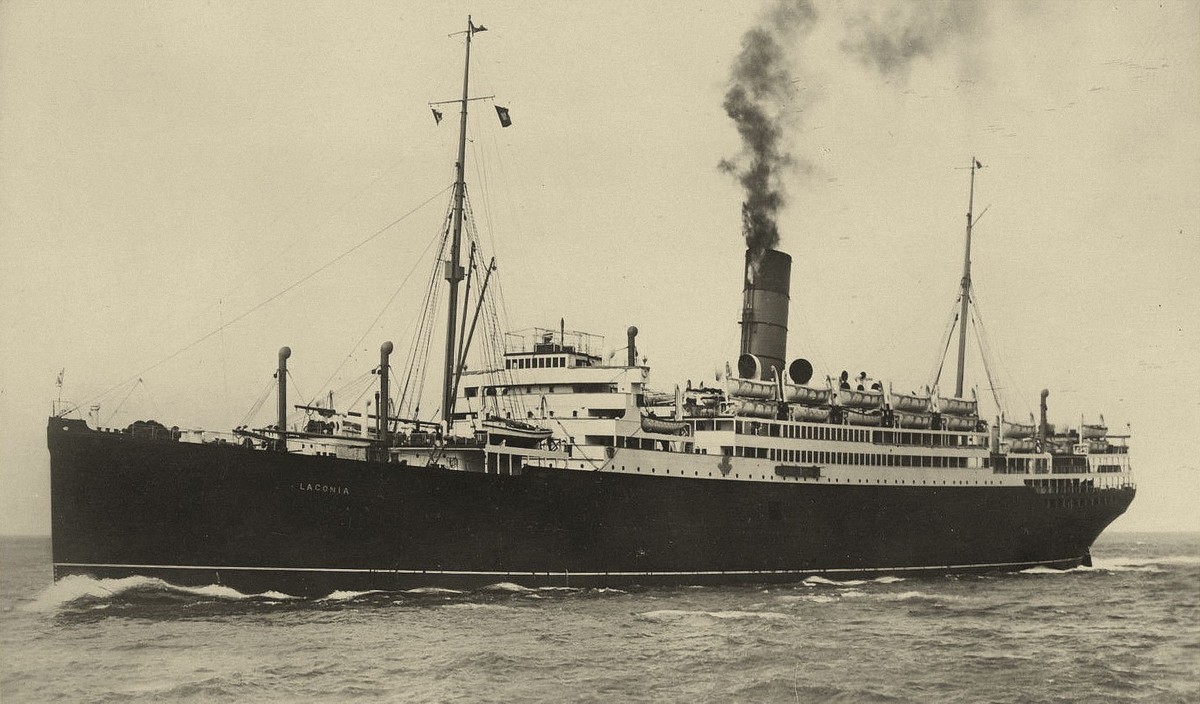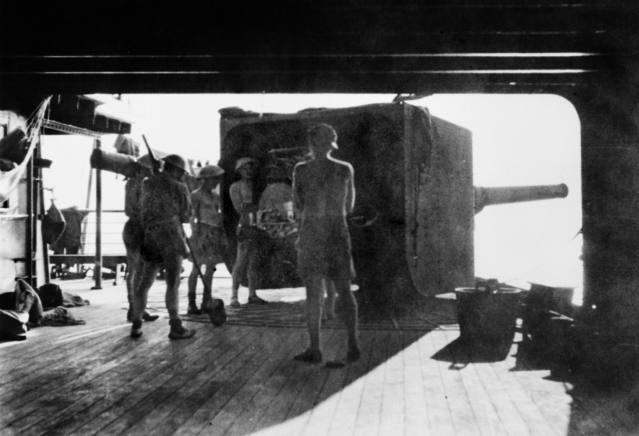HMS Laconia (RMS-1922, AMC-1939)
Back to Commonwealth Ships
List
Copied from Wikipaedia:
On 4 September 1939,
Laconia was requisitioned by the Admiralty and converted into an armed
merchant cruiser. By January 1940 she had been fitted with eight six-inch guns
and two three-inch high-angle guns. After trials off the Isle of Wight, she
embarked gold bullion and sailed for Portland, Maine and Halifax, Nova Scotia on
23 January. She spent the next few months escorting convoys to Bermuda and to
points in the mid-Atlantic, where they would join up with other convoys.
On 9 June, she ran aground in the Bedford Basin at Halifax, suffering
considerable damage, and repairs were not completed till the end of July. In
October her passenger accommodation was dismantled and some areas filled with
oil drums to provide extra buoyancy so that she would stay afloat longer if
torpedoed.
During the period June–August 1941
Laconia returned to St John, New Brunswick and was refitted, then returned
to Liverpool to be used as a troop transport for the rest of the war. On 12
September 1941, she arrived at Bidston Dock, Birkenhead and was taken over by
Cammell Laird and Company to be converted. By early 1942 the work was complete,
and for the next six months she made trooping voyages to the Middle East. On one
such voyage the ship was used to carry prisoners of war, mainly Italian. She
travelled to Cape Town and then set a course for Freetown, following a zigzag
course and undertaking evasive steering during the night.
On 12 September 1942, at 8:10 pm, 130 miles (210 km) north-northeast of
Ascension Island,
Laconia was hit on the starboard side by a torpedo fired by U-boat
U-156. There was an explosion in the hold and many of the Italian
prisoners aboard were killed instantly. The vessel immediately took a list to
starboard and settled heavily by the stern. Captain Rudolph Sharp, who had also
commanded another Cunard liner, RMS Lancastria
when she was sunk by enemy action, was gaining control over the situation when a
second torpedo hit Number Two hold. At the time of the attack, the
Laconia was carrying 268 British soldiers, 160 Polish soldiers (who were on
guard), 80 civilians, and 1,800 Italian prisoners of war.
Captain Sharp ordered the ship abandoned and the women, children and injured
taken into the lifeboats first. By this time, the ship's stern deck was awash.
Some of the 32 lifeboats had been destroyed by the explosions and some surviving
Italian prisoners tried to rush the lowering of the ones that remained. The
efforts of the Polish guards were instrumental in controlling the chaotic
situation on board and saved many lives. According to Italian survivors, many of
the POWs were left locked in the holds, and those who escaped and tried to board
lifeboats and liferafts were shot or bayoneted by British and Polish soldiers.
While most British and Polish troops and crew survived, only 415 Italians were
rescued, out of 1,809 who had been onboard.

Laconia in happier times.
At 9:11 pm
Laconia sank, stern first, her bow rising to be vertical, with Sharp
himself and many of the Italian prisoners still on board. The prospects for
those who escaped the ship were only slightly better; sharks were common in the
area and the lifeboats were adrift in the mid-Atlantic with little hope of
rescue.
However, before
Laconia went down,
U-156 surfaced. The U-boat's efforts to rescue survivors of its own
attack began what came to be known as the Laconia Incident.
When
Kapitänleutnant Werner Hartenstein, commanding officer of
U-156, realized civilians and prisoners of war were on board, he surfaced
to rescue survivors, and asked
BdU (the U-Boat Command in Germany) for help. Several U-Boats were
dispatched; all flew Red Cross flags, and signalled by radio that a rescue
operation was underway.
The next morning, a U.S. B-24 Liberator plane sighted the rescue efforts.
Hartenstein signaled the pilot for assistance, who then notified the American
base on Ascension Island of the situation. The senior officer on duty there,
Robert C. Richardson III, unaware of the Germans'
radio message, ordered that the U-boats be attacked. Despite the Red Cross
flags, the survivors crowded on the submarines' decks and the towed lifeboats,
the B-24 then started making attack runs on
U-156. The Germans ordered their submarines to dive, abandoning many
survivors. After the incident, Admiral Karl Dönitz issued the Laconia Order,
henceforth ordering his commanders not to rescue survivors after attacks. Vichy
French ships rescued 1,083 persons from the lifeboats and took aboard those
picked up by the four submarines, and in all around 1,500 survived the sinking.
Other sources state that only 1,083 survived and an estimated 1,658 persons died
(98 crew members, 133 passengers, 33 Polish guards and 1,394 Italian prisoners).
Amongst the French ships involved in the rescue were
Annamite,
Dumont-d'Urville and
Gloire.

Many more AMC's than just Laconia were used by the Royal Navy during World War
Two, but the Laconia Incident made the ship one of the most famous.
| Displacement |
20,000 tons standard, 24,200 tons full load |
| Length |
601 ft |
| Breadth |
74 ft |
| Draught |
32 ft |
| Machinery |
2shaft , steam turbines, 20,000shp |
| Speed |
16 knots |
| Range |
6000 miles at 14 knots, 3,500 @ 20 knots |
| Armour |
1" gun shields |
| Armament |
8 x 6" (8x1)
3 x 4.7" (3x1)
6 x 20mm (6x1) |
| Complement |
520 as AMC |
| Notes |

Australian troops man one of the 6" guns mounted on Laconia. |
|
Name
|
Comment
|
|
Alaunia |
|
|
Alcantara |
|
|
Andania |
Lost, 16 June 1940, sunk by
UA.
|
|
Antenor |
|
|
Antonia |
|
|
Arawa |
Decommissioned 25 July 1941, converted to troopship, survived the
War.
|
|
Ascania |
|
|
Asturias |
|
|
Aurania |
|
|
Ausonia |
|
|
Bulolo |
|
|
California |
|
|
Canton |
|
|
Carinthia |
Lost, 6 June 1940, sunk by
U-46 west of Ireland.
|
|
Carnarvon Castle |
|
|
Casanare |
Sunk 3 November 1940 along with HMS
Patroclus and HMS
Laurentic by
U-99.
|
|
Carthage |
|
|
Cathay |
|
|
Cheshire |
|
|
Chitral |
|
|
Cilicia |
|
|
Circassia |
|
|
Comorin |
Lost on 6 April 1941. Her burnt out wreck was sunk by HMS Broke.
|
|
Corfu |
|
|
Derbyshire |
|
|
Duchess of Richmond |
|
|
Duchess of York |
|
|
Dunnottar Castle |
|
|
Dunvegan Castle |
Lost on 27 August 1940, sunk by
U-46 west of Ireland.
|
|
Empress of Asia |
Lost on 5 February 1942.
|
|
Empress of Australia |
|
|
Empress of Britain |
Lost on 28 October 1940.
|
|
Empress of Canada |
|
|
Empress of Japan |
|
|
Empress of Russia |
|
|
Empress of Scotland |
|
|
Esperance Bay |
|
|
Forfar |
sunk by
U-99 on 2 December 1940.
|
|
Hector |
Was decommissioned when lost on 5 April 1942 during the Japanese
Indian Ocean raid.
|
|
Jervis Bay |
Lost on 5 November 1940 in an engagement against the German cruiser Admiral
Scheer. Her commander, Captain Fegen, was awarded a posthumous
Victoria Cross.
|
|
Kanimbla |
Transferred to the Royal Australian Navy as a Landing Ship Infantry
in 1943
|
|
Laconia |
Sunk |
|
Laurentic |
Lost on 3 November 1940, sunk by
U-99 west of Ireland.
|
|
Letitia |
|
|
Maloja |
|
|
Montclare |
|
|
Mooltan |
|
|
Moreton Bay |
|
|
Patroclus |
Lost on 4 November 1940, sunk by
U-99 west of Ireland.
|
|
Pretoria Castle |
Converted into an escort carrier as HMS
Pretoria Castle.
|
|
Queen of Bermuda |
|
|
Rajputana |
Lost on 13 April 1941, sunk by
U-108 west of Ireland.
|
|
Ranchi |
|
|
Ranpura |
Launched in 1924, commissioned as AMC in December 1939
|
|
Rawalpindi |
Lost on 23 June 1940, sunk by
Scharnhorst and
Gneisenau. Her commander, Captain Edward Coverley Kennedy, was
posthumously Mentioned in Dispatches.
|
|
Salopian |
Lost on 13 May 1941, sunk by
U-98, North Atlantic.
|
|
Scotstoun |
Lost on 13 June 1940, sunk by
U-25 north-west of Ireland.
|
|
Transylvania |
Lost on 10 August 1940, sunk by
U-56 north-west of Malin Head.
|
|
Voltaire |
Lost on 4 April 1941, sunk by German auxiliary cruiser Thor.
|
|
Wolfe |
|
|
Worcestershire |
Damaged by
U-74 on 3 April 1941
|
Royal Australian Navy
Royal New Zealand Navy
Royal Canadian Navy
-
Prince David
-
Prince Henry
-
Prince Robert
French auxiliary cruisers were armed with 138 mm, 152 mm or 150 mm guns, 75 mm
and 37 mm AA guns and 13.2 mm or 8 mm AA HMG
-
Aramis (X01)
-
Ville D'Alger (X03)
-
Cap des Palmes (X03)
-
Ville d'Oran (X05)
-
El Mansour (X06)
-
Victor Scoelcher (X07) (lost on 6 May 1942)
-
Colombie (X10)
-
Charles Plumier (X11)
-
Djenné (X13)
-
El Kantara (X16)
-
El Djezair (X17)
-
Eridan (X18)
-
Barfleur (X19)
-
Quercy (X20)
-
Esterel (X21)
-
Mexique (X22) (hit a mine and sunk on 19 June 1940)
Back to Commonwealth Ships
List


